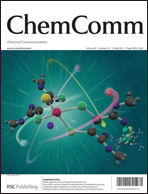Microwave synthesis of Au–Rh core–shell nanoparticles and implications of the shell thickness in hydrogenation catalysis†‡
Abstract
A microwave-assisted heating method allows for the convenient and reproducible synthesis of defined Au–Rh core–shell metallic

- This article is part of the themed collections: Celebrating the ChemComm Emerging Investigator Lectureship Winners and Emerging Investigators 2013

 Please wait while we load your content...
Please wait while we load your content...